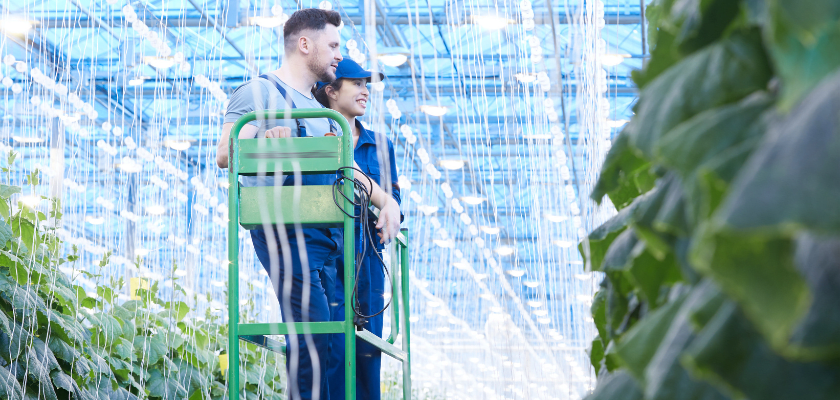Prevent struck-by injuries: Protect your workers and business with these 5 tips

Anyone who has worked in greenhouses knows what a hotbed of activity they are. “Between the workers, machines, and goods, something is always moving in a greenhouse,” says Joshua Paine, Specialized Consultant, Machine and Robotic Safety with Workplace Safety and Prevention Services (WSPS). “Anytime you have people working in close proximity to moving equipment, you have a risk of being struck by something.” He explains that without solid controls in place to mitigate this risk, the likelihood of injury can be quite high.
Struck-by injuries—when workers are struck by moving machinery, objects, or material—continue to be one of the leading causes of lost-time injuries in the province for greenhouse workers, according to the latest data from the Workplace Safety and Insurance Board (WSIB). These types of injuries also tend to have severe outcomes. “Powered mobile equipment and machinery, for example, can cause very serious injuries when contacting a worker,” says Joshua.
“Some common sources of struck-by hazards in greenhouses include things such as scissor carts, tote carts, tractors, conveyors, lift trucks, pallet wrappers, etc.,” says Joshua. “These are all an integral and necessary part of working in a greenhouse. Implementing reasonable solutions following the hierarchy of controls, paired with education and training on how to safely use and work around this type of equipment becomes critical to preventing struck-by injuries.” Plus, when you introduce automation and other emerging technologies, you are bringing in new hazards that need to be understood and controlled.
Identify the hazards and train your workers
Before you can train your workers on how to safely work around moving equipment, you have to understand what the specific hazards are and where your workers will encounter them. “Start by going through the tasks that workers perform to pinpoint how they could get hurt in the process of completing those tasks,” says Joshua. Once you have identified the areas where there is potential for a piece of equipment or material to make contact with a worker, implement controls to prevent it from happening.
For example, if you notice an area that has a high level of forklift or cart traffic with low visibility around a corner, you could create a pedestrian walkway separate from equipment, you could establish a one-way flow of traffic, or you could reorganize the work area to eliminate the low-visibility corner. “There are several ways to control a hazard. Consider what is most practical and effective for your workplace,” says Joshua.
Finally, train your workers so they know how to get the job done safely. “Education and awareness is key,” says Joshua. Develop safe work procedures and then provide training on those procedures. It’s important for workers to understand the seriousness of what can happen if procedures are not followed (i.e., life-altering injuries), so include this information in your training.
Five things to remember when implementing controls
- Remove language barriers. Training and procedures are effective only if they are understood. If you have temporary foreign workers, provide them with training in their first language. Use pictures and videos where possible to communicate how to safely perform a task and have workers demonstrate what they have learned to confirm that they understand.
- Ensure goods are stored and secured properly. Practice good housekeeping. Do not leave containers or carts in pathways or piled loosely off to the side somewhere. Plan ahead and designate a proper storage area. Make sure everything is properly secured to prevent something from falling on a worker.
- Maintain guarding on machinery. When proper guarding is in place, it prevents a worker from making contact with a moving piece of machinery. “To protect your workers, ensure adequate machine guarding is in place to prevent access to hazardous motion and workers are trained to recognize them,” says Joshua.
- Separate pedestrians and mobile equipment. More and more greenhouses are trying to maximize space, which often leads to workers and machines sharing space. Assess areas within the workplace where pedestrians may be exposed to mobile equipment hazards. Consider separating work areas and pedestrian walkways from mobile equipment to minimize the risk of contact as much as possible
- Stay on top of preventative maintenance. Avoid surprises by scheduling and conducting regular inspections of equipment, machines, and racking to ensure everything is in good working order (e.g., stability of shelving units, safety features on equipment, etc.).
Need more health and safety information?
Workplace Safety & Prevention Services (WSPS) is a not-for-profit occupational health and safety association committed to ensuring every worker goes home healthy and safe at the end of the day. As your dedicated health and safety association, we are here to help with resources and support, at no cost to you.
Find out how WSPS can support your business and access free resources to protect your business and team.
This article was originally published in The Grower.
The information in this article is accurate as of its publication date.




